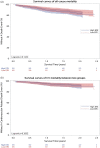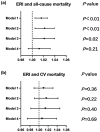The influencing factors of the erythropoietin resistance index and its association with all-cause mortality in maintenance hemodialysis patients
- PMID: 38234178
- PMCID: PMC10798285
- DOI: 10.1080/0886022X.2023.2290922
The influencing factors of the erythropoietin resistance index and its association with all-cause mortality in maintenance hemodialysis patients
Abstract
Anemia is a common complication of chronic kidney disease with major option treatment of erythropoiesis-stimulating agents (ESAs). This study aimed to investigate the influencing factors of erythropoietin resistance index (ERI) and its association with mortality in maintenance hemodialysis (MHD) patients. Patients enrolled from China Dialysis Outcomes and Practice Patterns Study (DOPPS) 5 were included. ERI was calculated as follows: ESA (IU/week)/weight (kg, post-dialysis)/hemoglobin level (g/dL). The Cox regression model was used to analyze the influencing factors on survival outcomes. Stepwise multivariate logistic regression was used to identify the related risk factors, and subgroup analyses were performed. A total of 1270 MHD subjects (687 males and 583 females) were included, with an average age of 60 (49.0, 71.0) years. All subjects were divided into two groups by the median ERI of 14.03. Multivariate logistic regression showed that dialysis vintage (OR 0.957, 95% CI: 0.929-0.986), white blood cells (OR 0.900, 95% CI: 0.844-0.960), high flux dialyzer use (OR 0.866, 95% CI: 0.755-0.993), body mass index (OR 0.860, 95% CI: 0.828-0.892), males (OR 0.708, 95% CI: 0.625-0.801), and albumin (OR 0.512, 95% CI: 0.389-0.673) had a negative association with high ERI baseline (all p < 0.05). There were 176 (13.9%) deaths in total including 89 cardiac/vascular deaths during follow-up. Cox regression analysis showed that ERI was positively associated with all-cause mortality, especially in some subgroups. ERI was associated with increased all-cause mortality in MHD patients, indicating the possibility of death prediction by ERI. Patients with high ERI warrant more attention.
Keywords: Anemia; erythropoietin resistance index; maintenance hemodialysis; mortality.
Conflict of interest statement
No potential conflict of interest was reported by the author(s).
Figures



Similar articles
-
Relationships among the Dosage of Erythropoiesis-Stimulating Agents, Erythropoietin Resistance Index, and Mortality in Maintenance Hemodialysis Patients.Blood Purif. 2022;51(2):171-181. doi: 10.1159/000506536. Epub 2021 Jun 25. Blood Purif. 2022. PMID: 34175850
-
Hepcidin serum levels and resistance to recombinant human erythropoietin therapy in hemodialysis patients.Medicina (Kaunas). 2017;53(2):90-100. doi: 10.1016/j.medici.2017.03.001. Epub 2017 Mar 31. Medicina (Kaunas). 2017. PMID: 28416170
-
Not baseline but time-dependent erythropoiesis-stimulating agent responsiveness predicts cardiovascular disease in hemodialysis patients receiving epoetin beta pegol: A multicenter prospective PARAMOUNT-HD Study.Int J Cardiol. 2023 Mar 15;375:110-118. doi: 10.1016/j.ijcard.2022.12.051. Epub 2022 Dec 30. Int J Cardiol. 2023. PMID: 36592827
-
Epoetin alfa resistance in hemodialysis patients with chronic kidney disease: a longitudinal study.Braz J Med Biol Res. 2018;51(7):e7288. doi: 10.1590/1414-431x20187288. Epub 2018 May 7. Braz J Med Biol Res. 2018. PMID: 29742267 Free PMC article.
-
Low sirtuin-1 levels are linked to erythropoietin resistance in hemodialysis patients.Ren Fail. 2025 Dec;47(1):2520909. doi: 10.1080/0886022X.2025.2520909. Epub 2025 Jun 23. Ren Fail. 2025. PMID: 40545983
Cited by
-
The Association Between Erythropoiesis Resistance Index and Clinical Outcomes in Hemodialysis Patients: A Nationwide Study.J Clin Med. 2025 Apr 18;14(8):2812. doi: 10.3390/jcm14082812. J Clin Med. 2025. PMID: 40283642 Free PMC article.
-
Associations between iron markers with hemoglobin and outcomes in peritoneal dialysis patients: results from the PDTAP study.Clin Kidney J. 2024 Dec 30;18(4):sfae427. doi: 10.1093/ckj/sfae427. eCollection 2025 Apr. Clin Kidney J. 2024. PMID: 40290139 Free PMC article.
References
MeSH terms
Substances
LinkOut - more resources
Full Text Sources
Medical
